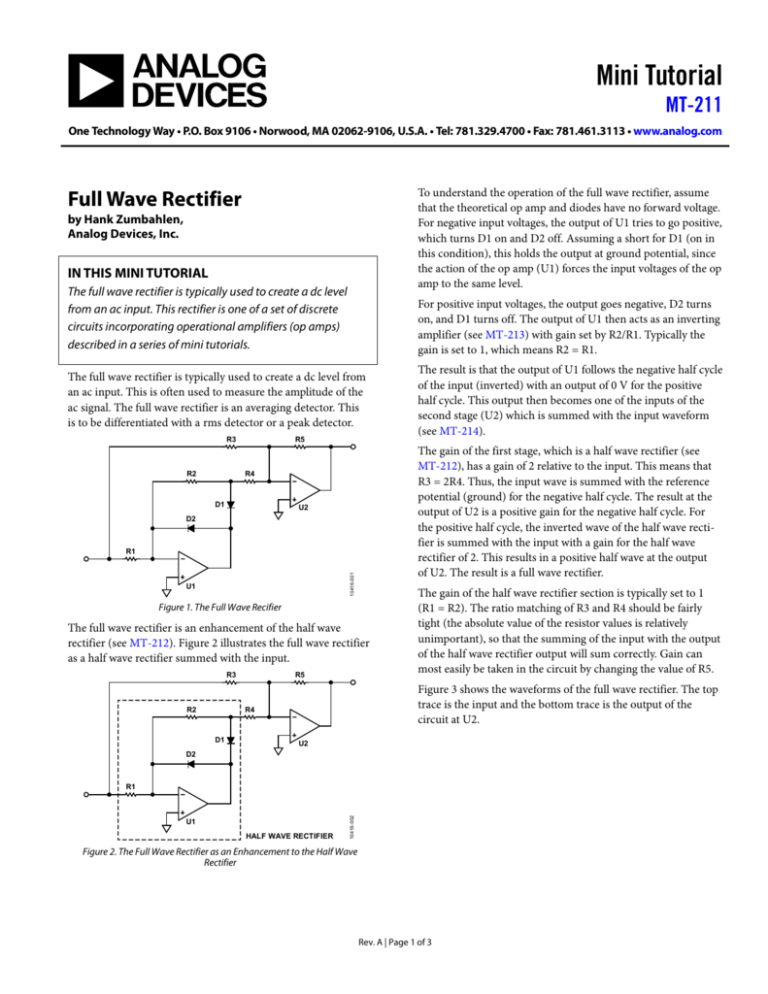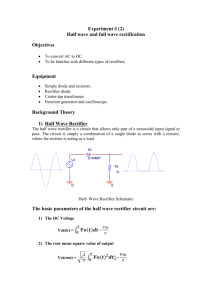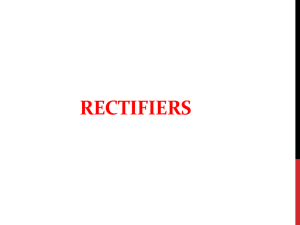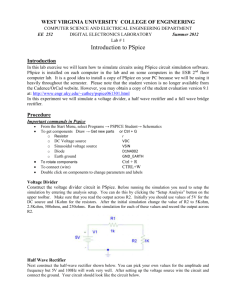
Mini Tutorial
MT-211
One Technology Way • P.O. Box 9106 • Norwood, MA 02062-9106, U.S.A. • Tel: 781.329.4700 • Fax: 781.461.3113 • www.analog.com
To understand the operation of the full wave rectifier, assume
that the theoretical op amp and diodes have no forward voltage.
For negative input voltages, the output of U1 tries to go positive,
which turns D1 on and D2 off. Assuming a short for D1 (on in
this condition), this holds the output at ground potential, since
the action of the op amp (U1) forces the input voltages of the op
amp to the same level.
Full Wave Rectifier
by Hank Zumbahlen,
Analog Devices, Inc.
IN THIS MINI TUTORIAL
The full wave rectifier is typically used to create a dc level
from an ac input. This rectifier is one of a set of discrete
circuits incorporating operational amplifiers (op amps)
described in a series of mini tutorials.
For positive input voltages, the output goes negative, D2 turns
on, and D1 turns off. The output of U1 then acts as an inverting
amplifier (see MT-213) with gain set by R2/R1. Typically the
gain is set to 1, which means R2 = R1.
The full wave rectifier is typically used to create a dc level from
an ac input. This is often used to measure the amplitude of the
ac signal. The full wave rectifier is an averaging detector. This
is to be differentiated with a rms detector or a peak detector.
R3
R2
R5
The gain of the first stage, which is a half wave rectifier (see
MT-212), has a gain of 2 relative to the input. This means that
R3 = 2R4. Thus, the input wave is summed with the reference
potential (ground) for the negative half cycle. The result at the
output of U2 is a positive gain for the negative half cycle. For
the positive half cycle, the inverted wave of the half wave rectifier is summed with the input with a gain for the half wave
rectifier of 2. This results in a positive half wave at the output
of U2. The result is a full wave rectifier.
R4
D1
U2
D2
10416-001
R1
U1
Figure 1. The Full Wave Recifier
The full wave rectifier is an enhancement of the half wave
rectifier (see MT-212). Figure 2 illustrates the full wave rectifier
as a half wave rectifier summed with the input.
R3
R2
R5
The gain of the half wave rectifier section is typically set to 1
(R1 = R2). The ratio matching of R3 and R4 should be fairly
tight (the absolute value of the resistor values is relatively
unimportant), so that the summing of the input with the output
of the half wave rectifier output will sum correctly. Gain can
most easily be taken in the circuit by changing the value of R5.
Figure 3 shows the waveforms of the full wave rectifier. The top
trace is the input and the bottom trace is the output of the
circuit at U2.
R4
D1
The result is that the output of U1 follows the negative half cycle
of the input (inverted) with an output of 0 V for the positive
half cycle. This output then becomes one of the inputs of the
second stage (U2) which is summed with the input waveform
(see MT-214).
U2
D2
U1
HALF WAVE RECTIFIER
10416-002
R1
Figure 2. The Full Wave Rectifier as an Enhancement to the Half Wave
Rectifier
Rev. A | Page 1 of 3
MT-211
Mini Tutorial
0
FULL WAVE RECTIFIER FOURIER ANALYSIS
–10
VOLTAGE (V)
–20
–30
–40
–50
10416-005
–60
–70
0
6k
4k
FREQUENCY (Hz)
2k
8k
10k
10416-003
Figure 5. Full Wave Rectifier Output Spectrum
Figure 3. Full Wave Rectifier Waveforms
Figure 4 shows the output of U1 and the output of the half wave
rectifier. Note that in a practical circuit the output of U1 is
actually running open loop until the forward voltage of D2
is reached. This is shown in the third trace from the top
(Channel C). The output of the half wave rectifier is shown
as the bottom trace (Channel D). The gain of all the traces in
Figure 4 are the same.
The summer section of the full wave rectifier can be turned
into a simple filter by the addition of a capacitor in the feedback network. The corner frequency of the filter is set by the
capacitor value and the value of R5 (F0 = 1/(2πR5C1)). This is
illustrated in Figure 6. In addition, this circuit can be followed
by an active filter.
R3
R5
C1
R2
R4
D1
U2
D2
U1
10416-006
R1
Figure 6. The Addition of a Capacitor in the Feedback Loop Converts the
Output of the Full Wave Rectifier to a DC Level
10416-004
The polarity of the output can be changed to a negative going by
reversing both of the diodes.
Figure 4. Full Wave Rectifier Waveforms with Half Wave Rectifier Output
The output of the full wave rectifier is often followed by a filter
to develop the dc level. The corner frequency of the filter should
be set low enough to limit the ac ripple on the output, but high
enough not to seriously impact the transient response speed of
the circuit.
The output spectrum of the output is shown in Figure 5. An
advantage of the full wave rectifier over the half wave rectifier
is that the frequency spectrum of the output is multiplied by a
factor of 2 due to the doubling of the output lobes due to the
rectifier action.
Error terms for the full wave rectifier are the same as for the
inverting amplifier (see MT-213). Most significant is the offset
term. The frequency response of the circuit is set primarily by
the open-loop gain of the op amp. The shunt capacitance of the
diodes and the diode turn on/ turn off time can also affect the
frequency response, but their effect is typically much less than
that of the frequency response of the op amp.
For operation with a single power supply voltage, the noninverting input is biased to a reference voltage, typically at
½ the supply voltage. The zero input signal output is then at
the reference voltage. Figure 7 shows a single supply half wave
rectifier with a reference voltage (the voltage at the noninverting input to the op amp) at +4 V. On the display, ground is
at the bottom.
Rev. A | Page 2 of 3
Mini Tutorial
MT-211
The input is still ground referenced, so the input must be ac
coupled using a series capacitor. The low end of the frequency
is determined by the RC time constant set by the input coupling
capacitor and the input Resistor R1. With bipolar supplies, the
circuit response is to dc. Alternatively, if the preceding circuit
is referenced to the same reference voltage, the input may be dc
coupled. Care should be taken if gain is taken in the circuit,
since the reference level as well as the signal is amplified.
OUTPUT
VREF
10416-007
The frequency response requirements on the op amp are
determined by the maximum signal input frequency. There
must be enough open-loop gain for the diodes to be biased. In
addition, there is a doubling of frequency due to the summing
action. Thus, apply the rule of thumb that the bandwidth of
the op amp should be at least 20 dB at twice the maximum
frequency of the input signal.
Figure 7. Single Supply Half Wave Rectifier Waveforms
REVISION HISTORY
2/13—Rev. 0 to Rev. A
Changes to Figure 1 and Figure 2 ................................................... 1
Changes to Figure 6 .......................................................................... 2
4/12—Revision 0: Initial Version
©2012–2013 Analog Devices, Inc. All rights reserved. Trademarks and
registered trademarks are the property of their respective owners.
MT10416-0-2/13(A)
Rev. A | Page 3 of 3









